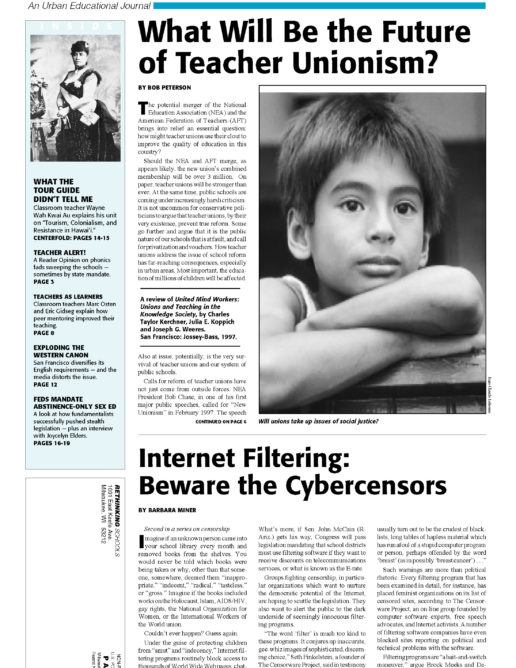Where’s the R-Word? Speaking Out on Textbook Silences
President Clinton has called for national conversation about it. Students talk about it. Even the media has become more willing to explore it. But school textbooks ignore it.
The “it,” of course, is race.
I was recently a member of a district committee adopting social studies textbooks for kindergarten through fifth grade. I found only one oblique reference to race or racism in the four U.S. history textbooks under consideration for fifth grade. Each book is over 650 pages and professes to cover U.S. history from the arrival of Native peoples through the 1990s.
Fifth grade is when students get their first sustained instruction in U.S. history. Every major textbook company and most of the nation’s school districts focus fifth-grade social studies on U.S. history, usually followed by another year of U.S. history in 8th and then 10th grade.
The four major textbook companies — Houghton Mifflin, Silver Burdett, Harcourt Brace, and Macmillan — offer brightly colored texts, with accompanying guides, supplements, and technological bells and whistles such as CD-ROMs, cassette tapes, and web sites. Over the years, the companies have made some progress in including people of all races in their books’ photos and text. They also proudly advertise the names of well-known multicultural educators as their advisors.
Nonetheless, the r-word is noticeably absent — except perhaps to those writing the texts. When I mentioned to one textbook company representative that there was no reference to race or racism in their U.S. history textbook, he responded, “Darn, that’s interesting. I hadn’t noticed that before.”
Another textbook representative was more to the point. She responded that the word “racism” had a “negative connotation” and so it really wasn’t appropriate to put in a U.S. history textbook. Hmm, I thought, “war” has a negative connotation too. Perhaps we shouldn’t mention the Revolutionary War or the Civil War in our history textbooks. Or “death” — what could be more negative? Perhaps we should pretend that George Washington is still alive?
A representative from a third company was the most up front. She explained that their company had tried to align their texts with the emerging state standards and that “racism” was not in those standards. Unfortunately, this explanation was all-too real. I had recently testified on the proposed Wisconsin state standards and had raised the concern that in the history standards for elementary and secondary students, the word “racism” doesn’t appear even once.
Regardless of one’s political orientation, such an omission is absurd. Do people think one can even minimally understand U.S. history without mentioning racism? Was the dispossession of Native Americans from their lands devoid of racial overtones? Did slavery and lynchings have nothing to do with race? What of the anti-Chinese riots at the turn of the century in which hundreds were killed?
REPERCUSSIONS
The issue involves more than acknowledging the stain of racism on our country’s past. By omitting the “r” word, texts help to obscure racism’s relationship to economic exploitation — whether in the case of slavery, the theft of Indian and Mexican land, the underpayment and mistreatment of Chinese railroad workers in the mid-19th century, or the use of Third World sweatshop workers today. Furthermore, if textbooks and educators can’t even discuss past racism, it makes it incredibly difficult to examine current problems of racism. Finally, when texts don’t talk about racism, they automatically eliminate any discussion of anti-racism. As a result, kids rarely learn of moments in U.S. history when people worked across racial lines for equality — as in the Black/Indian unity in the Seminole Wars and Black/white collaboration in the abolitionist and civil rights movements.
Whites have a particular responsibility to combat racism and yet few kids know of whites in U.S. history who have dedicated their lives to such a struggle: abolitionists such as John Brown, William Lloyd Garrison, Wendell Phillips, Prudence Crandall, Theodore Weld, Lydia Maria Child, Lucretia Mott, and Elijah Lovejoy, or civil rights leaders such as Anne Braden, Father Groppi, and Myles Horton.
As we approach a new century, it’s worth recalling the words of historian W.E.B. Du Bois nearly 100 years ago: “The problem of the 20th century is the problem of the color line.” If educators continue to ignore the issue of race, Du Bois’ prophetic words will ring as true for the upcoming century as they have for the past.

